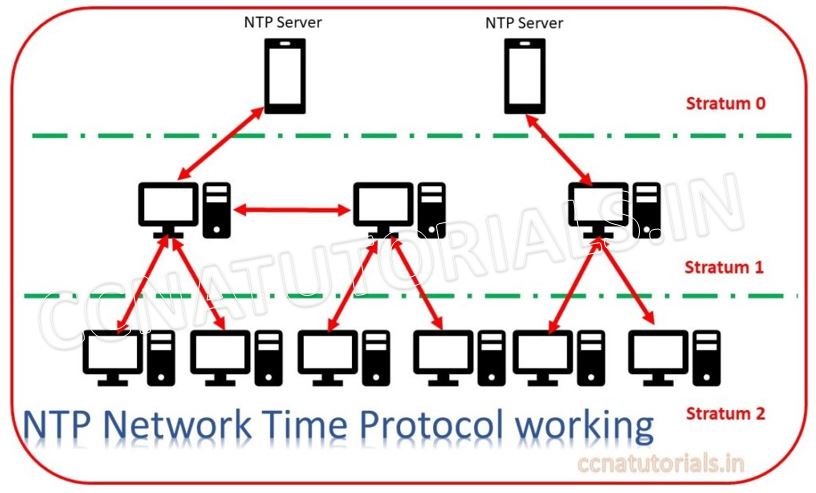In this article I describe the NTP Network Time Protocol in computer network for CCNA Exam. NTP Network Time Protocol provides the time synchronization between all the networking devices in a network. The importance of NTP Network Time Protocol is to keep the time synchronized of all networking device. Many protocols work on the basis of time. So it is necessary to keep the time of all networking same.
It is very difficult to maintain the time synchronization manually for all devices in the network. Time sync is necessary for time stamping in security devices for maintenance of logs. Network Time Protocol set the same time of all running systems in a network. Some broadcasting message in the network work on time basis. If the time of all devices is not same the broadcasting of any message will not perform the good result in the network.
NTP Network Time Protocol provide the time synchronisation of computer clock in a computer network. NTP Network Time Protocol works on the TCP/IP network and follow all the protocols of TCP/IP network. Network Time Protocol was developed in the year 1981 by David Mills. The NTP Network Time Protocol is a fault tolerant and scalable protocol. In a NTP enabled network no need to configure the time in the devices. The example of Network Time Protocol in general way is the smart phone time. We once set the time of our smart phone for automatic set according the network, then we do not need to set the time of smart phone manually.
Working of NTP Network Time Protocol
The clients of a network send time request to the NTP server. The NTP server provide the synchronization of time with other networking devices. The client then adjust the clock according to the time message received by the NTP server. The process of request and response between the client and NTP server run approx six times in 5 minute to set the accurate time with reference to the NTP server timing. After synchronization of time between the NTP server and client, the client update the clock on a fix interval of 10 minutes regularly. The Network Time Protocol works on UDP protocol to avoid the consumption of bandwidth of the network. The NTP messages broadcast on UDP port number 123.
Features of NTP Network Time Protocol server
There are thousands NTP servers working around the world wide on internet. The NTP serve provide the real time from automatic clocks and GPS clocks to the networking devices. The clients like our smart phone requires to contact with the NTP servers to update the time on a fix interval. The cost factor to update the time from NTP server is zero. When you connected with a network then you do not need to do any special request for time updation in your device. The example of Network Time Protocol is the time of railway clocks or the clocks of airport. All the clocks at railway and airport remain syncs all time. If the time is different at different location then it became very difficult to maintain the timings of train or flights.
Hierarchy of NTP Servers
NTP Network Time Protocol configured in a hierarchical client server model in the network. The top level of hierarchy contains the NTP servers to provide the time synchronization for the low level devices. There is always a reference clock used in the NTP enabled network. The reference clock server is known as Stratum 0 which is typically a GPS or satellite receiver. The reference clock server maintain the time syncs with the satellite. The clients of reference clock server known as stratum 1.

The clients of reference clock synchronize the time with the stratum 0 servers. So if I can say the reference clock is stratum 0 and next level is stratum 1, then the lower level clients can be allotted the stratum number in this sequence 2, 3 and 4 etc. Each stratum level machines synchronize the clock with the upper level server or computer in the network.
Explanation of NTP Network Time Protocol
NTP Network Time Protocol provides the facility to synchronize devices clock times in a network. Without NTP each device in the network will use its own configured time. Network Time Protocol works on application layer of the TCP/IP protocol model suite. NTP is designed to find the fault and debug the network issues in a network. Without synchronization of time in a network many protocols not function properly.
NTP Network Time Protocol uses packet switching for synchronization of time. Network Time Protocol provides the synchronization of time up to milliseconds in all network devices. Many times, we use the mobile network for auto update data and time. This is the best example of Network Time Protocol. NTP Protocol maintain time accuracy up to one millisecond in a network. NTP protocol functions in client-server architecture and peer to peer architecture both. Network Time Protocol works on port number 123 in a network using UDP protocol.
When a client of a network initiates requests for time synchronization. The Network Time Protocol response to the NTP server. NTP server send the time message to the client. Client will receive the Time synchronization message and adjust own time settings. The delay time is also managed by the client to adjust the time. NTP servers work with TCP/IP suite. NTP protocol uses User Datagram Protocol (UDP) on port 123.
Sometimes the NTP server use broadcast and multicast time synchronization in the network. During broadcasting of NTP message all clients set their clock according to the NTP service. In multicasting of NTP message only addressee clients set their clock. Multicasting generally done on request of clients for time synchronization.
Importance of NTP Network Time Protocol
Accurate time across a network is important for many reasons; discrepancies of even fractions of a second can cause problems. For example, distributed procedures depend on coordinated times to ensure proper sequences are followed. Security mechanisms depend on consistent timekeeping across the network.
File-system updates carried out by a number of computers also depend on synchronized clock times. Some predefined job need to run on a fix time. Time synchronization of all the networking devices allow to run the predefined jobs and produce the correct result. That’s all about the Network Time Protocol in a computer network.
In this article I describe the NTP Network Time Protocol in computer network for CCNA Exam. I hope you found this article helpful. For any query or suggestion you may drop a comment below or contact us. Your suggestions are always welcome by us.







I know this if off topic but I’m looking into starting my own blog and was curious what all is needed to get set up? I’m assuming having a blog like yours would cost a pretty penny? I’m not very internet savvy so I’m not 100% sure. Any suggestions or advice would be greatly appreciated. Cheers| а
When I originally commented I clicked the -Notify me when new comments are added- checkbox and now each time a comment is added I get four emails with the same comment. Is there any way you can remove me from that service? Thanks!